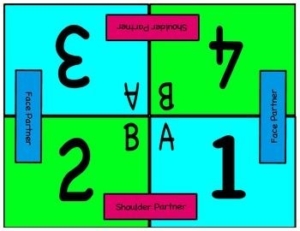We have all heard the term “accountable talk.” We get it, kids need to turn and talk to each other. They can’t sit and listen to us all day. But, how do we know that they are talking and learning? I know that we are supposed to walk around and listen and facilitate discussion, but what happens when we are talking to another group? How do you know that they are not talking about PokeMon Go? (Or anything else that is more important to them)
For many years, I thought that I was doing a great job of this. I was giving students the accountable talk stems, I was giving them time to turn and talk and then share out. So, why weren’t my students engaged in the learning that I was promised by all of the research?
The answer… quite simple. When I starting putting effective procedures in place for students to talk. DON’T STOP READINF YET!! I know… you think you already have the procedures in place. But, do you really?
Let’s look for example at a science investigation (since those are the most fun!!!)…
If students are working together and investigating, and you tell them to share with a partner what they just observed. Kids turn and tell their partner something and then they start talking about things that are off topic… Or, they both start talking at the same time and neither one is able to hear the other. In order for students to truly engage in meaningful conversation, there has to be “equity of voice.” And no it’s not just another buzz phrase… Stay with me on this.
Imagine if you had a procedure where on student shares what they observed and the other student than has to repeat what they heard and respond. They must discuss their reasoning for their response, and they hold each other accountable for talking and listening to one another. Like most things, it would take time and practice… but the conversations would be so much more student centered and based on what they were thinking.
Kagan has a great structure that could be used in any classroom.
When using these mats, you place them in the center of the student desks, and each student knows their number and letter. Before students turn and talk, you tell them that they are going to talk to either their face or shoulder partner, and that partner A or B is going to go first. After students have had a chance to share, the partner who was listening now has to repeat what they heard and then respond. Students never really know if they are going to talk to their shoulder partner or face partner, or who is going to talk first, so they must be ready to share at any point. They are also having to repeat what the other student said, and so they have to listen and think. You are now holding student more accountable for discussions.
After students have shared, they can either share again with the opposite partner (shoulder/face) or you can call on students to share out. This helps to change up the boring turn and just talk. They have a little bit more structure and will hopefully increase the quality of their conversations.
The first time you try this… maybe try it with something that you know they can talk about… Something simple, like what they did over the weekend. As you work through the barriers in your classroom you can add additional procedures as needed.
In case you don’t believe me… Here is some research!
“Accountable Talk® classrooms are filled with talk that seriously responds to and further develops what others in the group have said. It puts forth and demands knowledge that is accurate and relevant to the issue under discussion. This academically productive talk uses evidence appropriate to the discipline (e.g., proofs in mathematics, data from investigations in science, textual references in literature, documentary sources in history) and follows established norms of good reasoning. This discourse sharpens students’ thinking by reinforcing their ability to use and create knowledge.” (Michaels, O’Connor, Hall, Resnik, 2013)
For more information on this topic, based on the “Accountable Talk Sourcebook: For Classroom Conversation that Works” visit this website. For more information on Kagan Structures and Ideas, click here.

